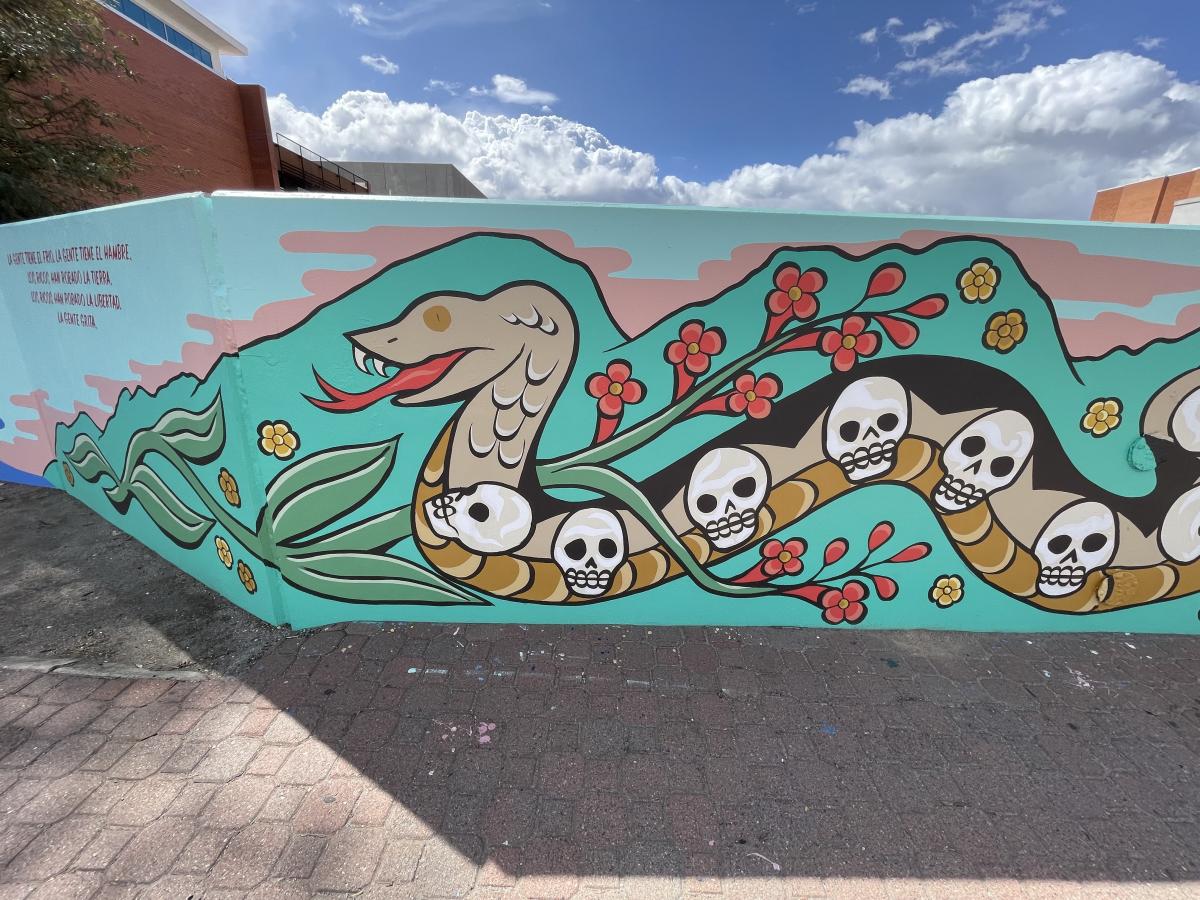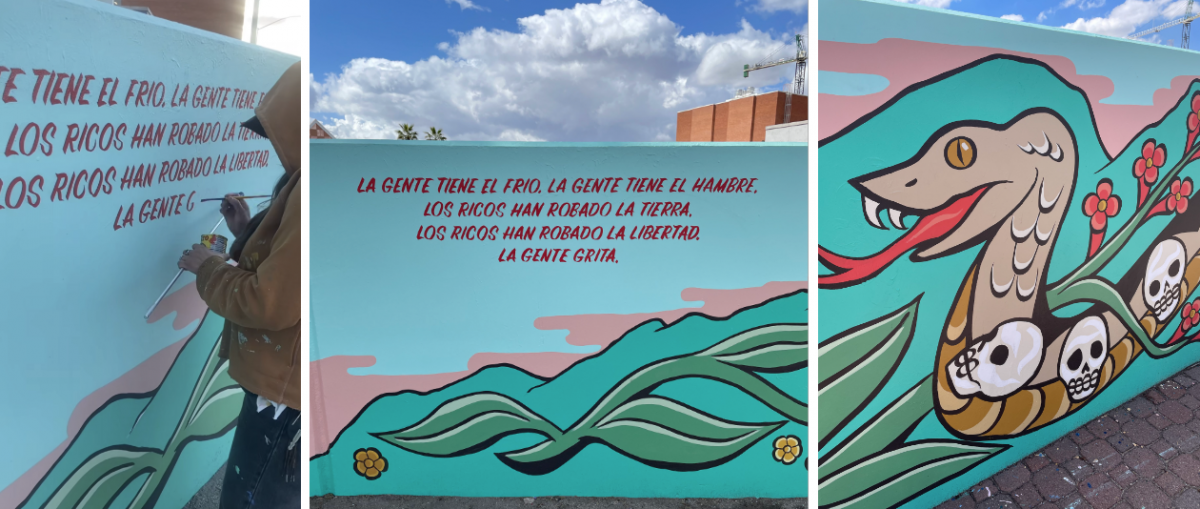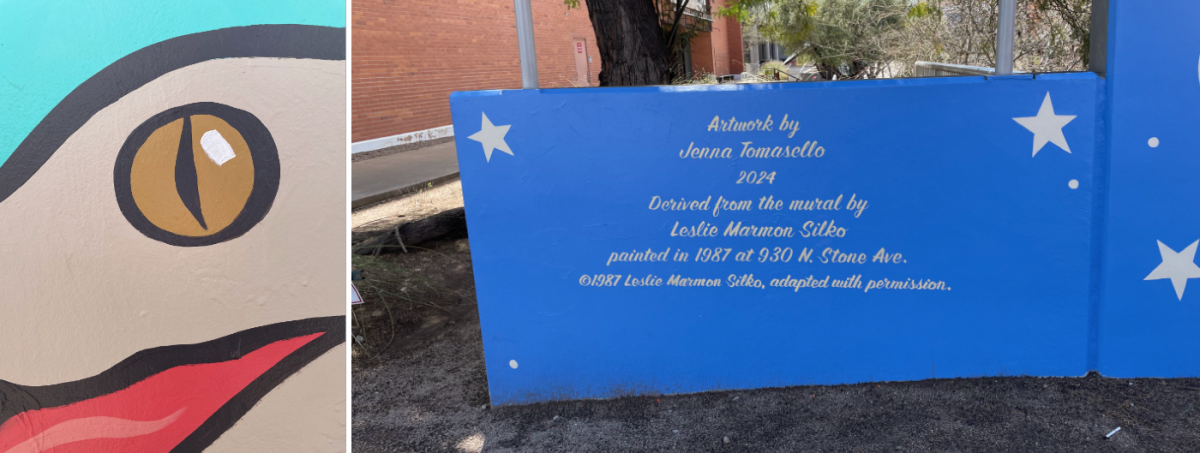In this series of interviews, Melissa Goodrich speaks to the artists who created poetry-inspired murals along the Speedway corridor. Today's interviewee is Jenna Tomasello.
It's art without an access barrier, you know?
It’s there on the street for the people.
—Jenna Tomasello

What led you to becoming a muralist?
I think it was like 2012 or 2013, I visited a friend in Dallas who is a muralist—Huy Nguyen—and I helped him on one of his mural projects, and I was like, “Oh, wow! I can do this.”
And I was a painter and artist before that, but that was like, really, what inspired it—was actually doing it with somebody, you know? And, and then I came back to Tucson after that, and I just, immediately just painted my first mural. So I've been painting murals ever since then.
What was your first mural that you painted?
It was at a house that I was living at. The building was not quite a garage, but like a studio building. My housemate had their art music studio in this kind of garage building, and I painted both the outside and the inside with like mural designs. It was a triangle abstract pattern that flowed almost like mountains. And then I painted the cactus at the bottom, too.
How would you describe your style or your influences?
I really like bold—bold and colorful. I don't do a lot of blending. I choose my colors ahead of time and go for, like, a pretty straightforward, clean look, usually with a dark outline on things.

I'd love to know about what inspired the mural, and yours is kind of special because it's a recreation. So can you tell me about that?
So when the six of us got together to discuss this project, like the six artists, we had a meeting where we all got together and we were discussing, “Do we have a theme for this? Like, is there a way that we bring these all together, or do we all just do our own thing and let it be what it is?”
And then when we decided on the theme of each creating a mural based on a poet related to Tucson. So I had known about Leslie's snake mural. I’ve looked at photographs of it like it's something that was on my mind.
When I knew which wall I was getting, and I knew the shape of it—that was my first thought. I immediately thought of the snake mural and the vision came to me of what it could be.
And so I reached out to Leslie and contacted her and asked if I could paint her snake. And she she said yes. And she also told me a story of how in the Pueblos where she's from, they had murals. And when they would go to repaint the murals, something would always change. Like color would change or something. In the repainting of it, it never stayed the same. And so in that way, she gave me the blessing to like, do it and paint it and change it.
How did you add your own style and your own interpretation to it? Can you tell us about your process and what you did?
I mean, I was looking at photographs of hers and really I was thinking about the feeling of it, the imagery of it. I mean, the imagery of it is like snakes with a bunch of skulls in a belly. And I loved how the snake was also like the mountain line, the mountain ridge—like the snake and the mountain were one.
And I loved the the rain clouds with the lightning and the flowers, and it had the sky around it, and I just took it in and looked at all the elements of it and really sat with it for a while and then did a bunch of sketches and I drew it out. I had to draw it out on paper and I drew it to the scale of the wall. So I took measurements of the wall and then had a sheet of paper that was like the same size, but scaled down, you know, and I did a number of sketches and revisions of it until I came to what worked for me.
And then I left a bit of interpretation to happen at the end. So I had like, the basic plan, you know, like the outline for how the snake was going to be. But I also wanted to leave a little bit up to interpretation for when I got there, because, you know, Leslie painted that piece when she was writing Almanac of the Dead, and she was having writer's block.
And so it was a way to, like, do something else for a while, and then I guess the rest of the story came to her after she completed the painting. And so I wanted to also allow for a bit of something visionary in that way.

So, it's like, 'The people are cold, the people are hungry, the rich have stolen the land. The rich have stolen the freedom,
and the people revolt.' And it's just, like, totally still relevant today."
Why do you think public art, like murals, is so important?
It’s so important! It's art without an access barrier, you know? And I was so humbled by painting at the bus stop—just meeting a lot of people who use that bus stop and are regulars there. It’s there on the street for the people, you know.
Yeah. And it's it's, it's fun and brings creativity and color to our city. I feel like so much architecture is built right now in a way of being like the most cost-effective and fastest way to be done, you know? And it's like bringing an element of art and creativity and story of our lives to the city.
Similarly, why do you think poetry is important in poetry?
It's another translation of the human experience!
Do you have a particular way that you hope folks respond to your art when they see it?
I don't know. I don't I don't know if they think about that too much. I hope everybody enjoys it, but inevitably, you know, you can't please everybody. I try to just always do my best work that I can produce. There's a lot that goes into everything—and it's not just my murals, but like all the work I do. I'm also a tattooer. And every piece I do, everything I do for somebody, I always try to make it my best. And as soon as it's done, it becomes a thing of the past. And your next piece is the next new thing.
I'm ever-changing, the world around me is ever-changing, and I do the best I can at the time.
Do you get to make art full time?
Yeah, I do actually! After the first mural I ever did, I worked as a set painter painting the backdrops for theater. I did that for a number of years in combo with—I've always done murals. That's been fun for me—just putting art out into the world is fun.
But I did set painting for a number of years and that's how I got really skilled at painting. And then I also do merchandise design. In 2018, I started designing my bandana collection. They're in a number of stores around town. Now I also do custom ones for businesses and t-shirts and pens and stickers.
It's evolved into this whole thing now where I make a whole like merchandise collection and have that out in the world too. So I do that. And then, fairly recently, I'm a tattoo apprentice at The Painted Lady.

How do you feel about the whole project coming together and working with all these different artists?
It's so cool! Because we've been in the planning process for this over a year. And it’s been such a big effort on everyone’s part. Allison [Miller] was the organizer who was the one who pitched the project.
There was a call to artists, and we all applied and then submitted our designs, and there was like a board that chose us and approved the designs and all these things. It was such a big effort. And we approached the city with the project and were like, “We want to do this for the city!” and—that’s different. That's not usually how the city gets murals done.
Why was it really important to do this along the speedway corridor?
Alison has been wanting to paint these walls for, I think, like ten years or something like that.
She just had this idea about, you know, a lot of people drive past there. A lot of people walk past there. A lot of people take the bus past there. You know, it's a busy area and those are great walls for painting. So why not paint them?
Is there anything else you’d like to add?
I really want to honor Leslie's work with what I do, you know, and make sure that she gets her credit and respect. It’s really important for me to make sure that she is also acknowledged in this too.
I think that's what makes the mural that you're working on so unique—that it's your work and a resurrection of Leslie's work.
And the message of it is important, too. And I am not still not quite done with the mural—but there’s going to be like an acknowledgment on a section of the wall that’s painted blue. There's a moon in the sky—I need to finish the moon—and then right next to it, there's a section of the blue wall that's blank. And that's where I'm going to put the acknowledgment and credit her and all that.
It's not 100% done yet. And I haven't painted the eye of the snake yet. I was saving that part for last —of, like, bringing the soul to the painting by painting the eyes last.

Oh wow!
And the quote—that was in the original painting too. So that felt really powerful to paint.
The quote is: La gente tiene el frio. La gente tiene el hambre. Los ricos han robado la tierra. Los ricos han robado la libertad. La gente grita.
So, it's like, “The people are cold, the people are hungry, the rich have stolen the land. The rich have stolen the freedom, and the people revolt.” And it's just, like, totally still relevant today. It's a powerful painting, you know?
_____
Jenna Tomasello (@jennatomasello) is a Tucson based artist whose paintings illustrate a feminine mysticism of the natural world. Tomasello works in commercial art and merchandise design and has a professional background in theatrical scenic painting. Tomasello has painted several murals throughout Tucson and has volunteered with Alley Cat Murals since 2016, intent on inspiring the city with creativity and color.

